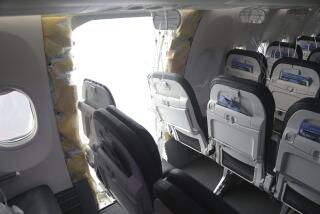British Ground 737s to Check Warning Systems : Move Termed ‘Precautionary’; Possibility of Instrument Failure Suggested
- Share via
LONDON — The Civil Aviation Authority, in what it described Wednesday as a “precautionary” move, ordered British airlines to ground all their late-model Boeing 737 aircraft pending an inspection of their engine fire-warning systems.
It was the first suggestion that some sort of instrument failure may have contributed to last Sunday’s crash of British Midland Airways Flight 092. Forty-four passengers died and 82 other passengers and crew were injured as their crippled aircraft undershot the runway at a central England airport during an emergency landing attempt.
The agency said it is also “urgently” preparing detailed instructions for more frequent mandatory engine inspections on the newer Boeing 737s, as well as European-built Airbus A-320s, which use the same power plant but have different warning systems. Initial checks will have to be performed on those airplanes within 24 hours of the new instruction being issued, according to the agency.
The agency said it was acting upon recommendation of investigators probing the British Midland crash, which involved a 12-week-old Boeing 737-400 series twin-engine jet. And while the Transport Ministry stressed in a separate statement Wednesday that “much work remains to be done” to pin down the exact cause of the disaster, the order served to shift speculation back toward technical malfunction after speculation the day before that pilot error might have been involved.
While the order immediately affects only 37 aircraft here, it has implications for several times that many planes, many of them in service with American carriers.
A spokesman for the International Air Transport Assn. said in a telephone interview from Geneva on Wednesday that more than 250 aircraft have been equipped with the late model CFM-56 engines that are subject of the CAA order. That order, he added, puts “fairly compelling pressure on other governments to take similar steps,” if only because of the potential liability if there were now a similar accident involving the targeted planes.
Alerted to developments by the British, the U.S. Federal Aviation Administration ordered similar warning-system inspections of 300 late model 737s flown by American carriers, wires
Starboard Engine Cut
According to the official account of the England crash so far, Flight 092 pilot Kevin Hunt reported shortly after taking off from London’s Heathrow Airport for Belfast, Northern Ireland, on Sunday evening that he had shut down his starboard (right) engine because of a fire. He was diverted to the East Midlands airfield, Britain’s 11th largest, about 110 miles northwest of here.
As he neared East Midlands, witnesses reported that his port (left) engine was in flames, and the aircraft slammed into an embankment alongside England’s busiest highway, the M-1, breaking into three pieces. It was about 500 yards from the end of the runway.
“Evidence obtained early in the investigation indicated that both the No. 1 (port) and No. 2 (starboard) engines might have suffered a related failure,” according to a Transport Ministry statement Wednesday. While physical evidence as well as information from the plane’s flight data and cockpit voice recorders confirmed in-flight failure and fire of the port engine, investigators have so far found no evidence of fire or other malfunction in the starboard engine.
The ministry stressed that “a great deal of significant evidence relating to this (starboard) engine has yet to be obtained.” However, its findings had fueled widespread speculation here that Hunt might have mistakenly shut down his “good” (starboard) engine instead of an already crippled port engine.
“Pilot Shut Off the Wrong Engine,” asserted the main headline in the tabloid Sun newspaper Wednesday. “Fatal Error,” proclaimed the Daily Star.
While pilot error may still prove to be a factor, however, the aviation authority’s announcement made it clear that such judgments are at least premature.
The airplane’s engine monitoring system includes separate heat and vibration sensors in the left and right engines, and separate alarms in the cabin to warn of a problem, according to aircraft experts here. At one point, however, the left and right systems pass through a common circuit.
What the agency’s directive means, these experts said, is that it is now thought possible that because of some technical fault, the warning system in Flight 092’s cabin may have indicated fire in the right engine when it was actually the left that was malfunctioning. That could have misled Hunt into shutting down the wrong engine, according to this theory.
From the cockpit, it is impossible to see either engine on a Boeing 737, the experts noted.
Possible Source Found
“They have pinpointed a possible source of the problems the captain experienced,” commented Freddy Yetman, technical secretary of Britain’s Air Pilots Assn. He added that the association had “protested strongly” over earlier suggestions of pilot error because they were “without a shred of evidence.”
Yetman conceded that it also “seems unimaginable” that the ultra-sensitive engine fire warning system could have failed.
Workmen removed both engines as well as the wreckage of the fuselage from the M-1 embankment Wednesday, shifting it onto the road itself until it can be hauled away for further inspection.
The engines will be taken to the facilities outside Paris of SNECMA, the French manufacturer which, in partnership with America’s General Electric, makes the CFM. There, the power plants are to be stripped down to find out what went wrong.
Transport Ministry officials here said it is still possible that closer analysis will reveal a malfunction of the starboard engine that was not apparent from the on-site inspection.
Hunt Questioned
Also as part of their continuing probe, officials of the Air Accident Investigations Board questioned Hunt in the hospital Wednesday. He is at least temporarily paralyzed with injuries.
A spokesman at the Leicester Royal Infirmary, where he is being treated, said Hunt was “anxious” before the meeting but relieved afterward.
Michael Pepperman, the doctor in charge of the intensive care unit, said that while hospital staff had kept from Hunt some of the harshest press accounts so as not to undermine his medical recovery, “we have made him aware of the comments that have been raised, and he hasn’t passed any comment.”
Following the Air Accident Board’s recommendations, the Civil Aviation Authority said British airlines flying Boeing 737-300 and 737-400 series aircraft “are being required to carry out checks of the fire, overheat, and vibration monitoring systems on their aircraft.” While the ill-fated British Midlands plane was a 737-400, it is basically a stretched version of the 737-300. It uses virtually the identical CFM-56 engines.
Earlier versions of the 737 carry a different engine.There are also earlier versions of the CFM-56 engines that are not affected by the agency’s order.
After Sunday’s crash, there are three Boeing 737-400s on the British registry of commercial aircraft, and all were immediately grounded voluntarily by their operators. The new engine warning system checks “are required to be satisfactorily completed before further flight,” the CAA said.
Checks on Series 300 Boeing 737s “must be carried out before the first flight after midnight tonight,” Wednesday’s order said. There are 30 Series 300 aircraft in use here, operated by nine different airlines. The carriers said they hope to carry out the checks without disrupting their schedules.
More to Read
Inside the business of entertainment
The Wide Shot brings you news, analysis and insights on everything from streaming wars to production — and what it all means for the future.
You may occasionally receive promotional content from the Los Angeles Times.









